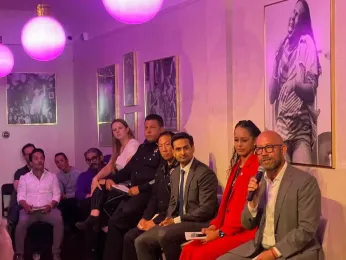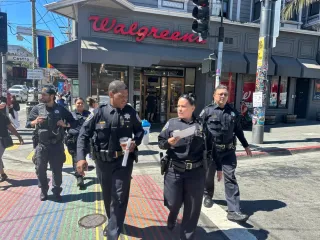
Jul 11
At Castro town hall SFPD, DA discuss limits of their powers amid ICE activity
John Ferrannini READ TIME: 8 MIN.
San Francisco law enforcement officials discussed the perils and pitfalls of working on the streets as masked U.S. Immigration and Customs Enforcement officers try to meet Trump administration deportation quotas. The local officials acknowledged at a Castro town hall that their powers are limited.
Gay Board of Supervisors President Rafael Mandelman read an audience question at a standing room only public safety forum July 10 at The Academy, 2166 Market Street, asking if people should call the police if there are “folks driving around in vans with masks on and they’re identifying themselves as federal officials, but that’s not who they are, it seems.”
Lientenant Manny Bonilla, the acting captain of the San Francisco Police Department’s Mission Station, answered, “It’s a super sticky situation.”
“I would say if there’s some sort of individual, and you think something is amiss, call 911. We will check it out,” he said. “What I would warn against is if you think it is some kind of ICE agent, kind of jumping into the fray."
Bonilla explained that due to San Francisco’s sanctuary city laws, the police can’t help facilitate federal immigration law enforcement; however, state and local municipalities also can’t obstruct such actions.
“I would say if you’re concerned with someone maybe pretending to be someone in order to perpetrate a crime, call us,” Bonilla concluded. “I don’t suggest someone takes matters into their own hands, but be a good witness, call 911, and we can try to deal with these sorts of things.”
Fears both of ICE agents, and reports in multiple media outlets that civilians are impersonating them in order to commit crimes, including sexual offenses, have skyrocketed since White House Deputy Chief of Staff Stephen Miller set a quota of 3,000 arrests per day for the agency.
ICE agents have also been wearing masks, ostensibly to protect their identities from doxxing.
Law enforcement agencies such as the San Francisco Police Department are required to identify themselves. State and federal officeholders have introduced legislation in an attempt to prohibit agents from concealing their identities.
At the state level, gay state Senator Scott Wiener (D-San Francisco) has introduced Senate Bill 627, termed the No Secret Police Act. Its aim is to unmask the federal officers.
“The recent federal operations in California have created an environment of profound terror. If we want the public to trust law enforcement, we cannot allow them to behave like secret police in an authoritarian state,” Wiener stated in a June 16 release announcing the bill. “Law enforcement officers do critically important work to keep our communities safe, and they should be proud to show their faces and provide identifying information when doing so. It boosts trust in law enforcement, which makes it easier for law enforcement to do their jobs and makes California safer for all of us.”
Corresponding federal legislation is being pushed by Senator Alex Padilla (D-California) and is termed the VISIBLE Act. Padilla was briefly detained himself by federal officials while attempting to question Homeland Security Secretary Kristi Noem at a Los Angeles news conference last month.
“When federal immigration agents show up and pull someone off the street in plainclothes with their face obscured and no visible identification, it only escalates tensions and spreads fear while shielding federal agents from basic accountability,” Padilla stated. “Immigration agents should be required to display their agency and name or badge number — just like police and other local law enforcement agencies. The VISIBLE Act’s commonsense requirements will restore transparency and ensure impersonators can’t exploit the panic and confusion caused by unidentifiable federal immigration enforcement agents.”
Despite rhetoric from Trump administration officials that the agency is only targeting criminals, fewer than 30% of those in ICE detention as of June 23 have been convicted of crimes, and 47% don’t have any criminal record, according to internal government documents obtained by CBS News.
San Francisco District Attorney Brooke Jenkins was also at the Castro forum. She, too, said her hands are tied.
“We are obviously horrified with what’s going on,” Jenkins said. “It is in San Francisco, and it’s happening already, and in our disgust everyone’s trying to figure out, ‘What do we do?’
“As far as obstructing federal agents, there is nothing I can do as the prosecutor for the city to help,” Jenkins continued. “We do have folks in the city trying to stand up for our brothers and sisters right now who are being literally kidnapped, but once you put your hand on an ICE agent, once you do anything they consider to be illegal, it is a federal prosecution.”
On the heels of news that a drag queen who’d legally been seeking asylum in the U.S. was detained by ICE in San Francisco just before Pride, as the B.A.R. reported, agents pointed rifles and used pepper spray on about 20 protesters trying to block their entry to San Francisco Immigration Court at 100 Montgomery Street on July 8, Mission Local reported.
Federal budget tripled
President Donald Trump’s budget act, which he signed July 4, triples ICE’s budget, and earmarks $140 billion for immigration enforcement.
Deputy SFPD Chief Derrick Lew, who was also at the forum, spoke to a social media video, in which the poster stated SFPD officers were facilitating an ICE operation. (The B.A.R. viewed the video – taken outside the ICE field office at 630 Sansome Street – via Instagram the previous day, but was unable to relocate it Friday.)
“We have to draw the line so people don’t get hurt,” Lew explained. “In this particular case … they will respond in whatever way they feel. It’s just there may be times the police department needs to act in a peacekeeping way and divide the line. It’s not going to look great for us, but we’re in this really difficult situation.”
Rounding out the forum attendees was Kunal Modi, Mayor Daniel Lurie’s health and human services czar; and Adrienne Bechelli, director of the coordinated streets program.
Only a handful of audience questions were read after having been submitted on paper.
Nate Bourg, a gay man who is proprietor of The Academy and is also the current Castro Merchants Association president, was proud the forum turned out so many people.
“There’s a lot of people in the room, and looking at the guest list, if we could bottle up some of the collective energy and experience of the people in this room and use it, that would be pretty amazing,” he said. “I’m really, really humbled to see the response of so many people to be here.”
Local property crime declines, officials say
The forum was initially called for after a series of violent incidents in the Castro during the spring, which led Lurie and then-Police Chief William Scott to add more of a police presence in the area, as the B.A.R. first reported.
As the department looks for a new chief, Lurie’s former public safety czar Paul Yep is serving in the position in an interim capacity. Bonilla, too, is new to the Castro; as the B.A.R. reported last week, Mission Station is looking for a new captain after the departure of Liza Johansen.
As that article stated, Johansen made burglaries a priority during her time at the station, which covers much of the Castro neighborhood.
“That proved to be a success,” Bonilla said.
Bonilla said that officers stopped at houses where occupants had left their garage doors open to tell them to close them, which he said contributed to a decline in burglaries.
Jenkins and Lew said blitz operations at retailers have also brought down property crime rates – aided by new laws such as Proposition 36, which increased penalties and felony charges for crimes that had been misdemeanors. The proposition increased the penalty prosecutors could seek for repeat shoplifters with two or more prior convictions of $950 in value or less to a felony punishable by up to three years in prison.
This helped prosecutors because “it would take someone stealing half of Walgreens to get to $1,000,” as Jenkins put it.
Though Prop 36 didn’t go into effect till near the end of 2024, Jenkins said that last year there was a 30% drop in reported retail theft citywide.
Many of the issues the panelists spoke to were citywide ones – such as how to address open air drug scenes, organized retail theft, and the relation between the two.
Lew said that “the constant theft from our retail outlets is to finance a lot of the user population’s ability to buy drugs, so it kind of goes full circle that way.”
Modi said that for many years, citywide discourse has conflated open air drug scenes and mental health issues with homelessness, but that each individual’s case is different.
For example, he offered that 26% of the city’s overdose deaths happen in permanent supportive housing, and only 51% of people experiencing homelessness have a mental health crisis they are dealing with.
Modi said, “We need to show up with a Swiss Army knife” of options to be more precise in addressing issues.
RESTORE program
Earlier this year, the city expanded its Rapid Engagement Shelter and Treatment for Opioid Recovery, or RESTORE, program, which operated 35 short-term beds at the Adante Hotel, 610 Geary Boulevard. Modi said that 70% of people who enter the RESTORE program are in treatment within two weeks – and 35% are on a pathway to stability. Modi did not indicate the number of people who have entered the program.
“So, to put it in context, [about] a quarter of people you meet in the worst fentanyl addiction, getting to something more stable? We need to lean into those solutions,” he said.
Another way Lurie’s administration is trying to adopt that precision approach is by reorganizing the nine previously siloed organizations across seven departments – police, fire, sheriff, public works, public health, Homelessness and Supportive Housing, and emergency management – so that neighborhoods will have a unified street outreach team.
“What we’ve tried to do is bring the nine different street outreach teams into one big model, so our current street crisis response teams are part of a more interdependent model,” Modi said.
Modi said that the city’s system of care has 25,000 beds, spread across different departments and partners.
“What we have a gap in is [beds for] the first 48 hours of crisis stabilization,” he said. “This needs to look more like how Kaiser or any other professional health system looks at their system of care.”
Bechelli said that every morning, those teams are assessing street conditions.
“For example, this morning in the Castro, tents, zero, individuals, six, and then what we do every single day is we get on an 8:30 [a.m.] meeting with all of our partners,” Bechelli said.
However, oftentimes when the city arrives, “they are no longer there,” she added.
“What we’ve seen in the Castro, in particular, is the population we are seeing really is transient,” she continued, meaning that they’re just passing through.
Bonilla agreed with Mandelman that some of these individuals, alleged to be responsible for some of the violent outbursts of the spring, including a brazen assault on Easter Sunday, were displaced after efforts to reduce the transient population in the Civic Center, on Sixth Street and in the Mission. He emphasized that the Castro is one of the few neighborhoods that has police walking the beat every day.
“If I had my way, I’m super grateful for the beats, but we’d have a sector car going around at night,” Mandelman said. “How many cars are there at night and where are they going?”
Bonilla said that there’s always one car, staffed daily, for the Castro, but that the ongoing SFPD officer shortage is the main reason there is not even more of a police presence.
In response to an audience question, Bonilla wanted to make sure the public was aware that there is an online tool to upload photos and video to the SFPD’s website without waiting for an officer to arrive, as well as the option to file a police report at the top of the site.
On the same page people can also request an incident report copy.
A variety of incidents can be reported online, including harassing phone calls, vandalism or graffiti, vehicle burglary, and some types of vehicle theft.
Other incidents must be reported at a police station. These include residential burglaries, robbery incidents, and traffic collisions, including hit-and-runs.
The full list is available on the site.


